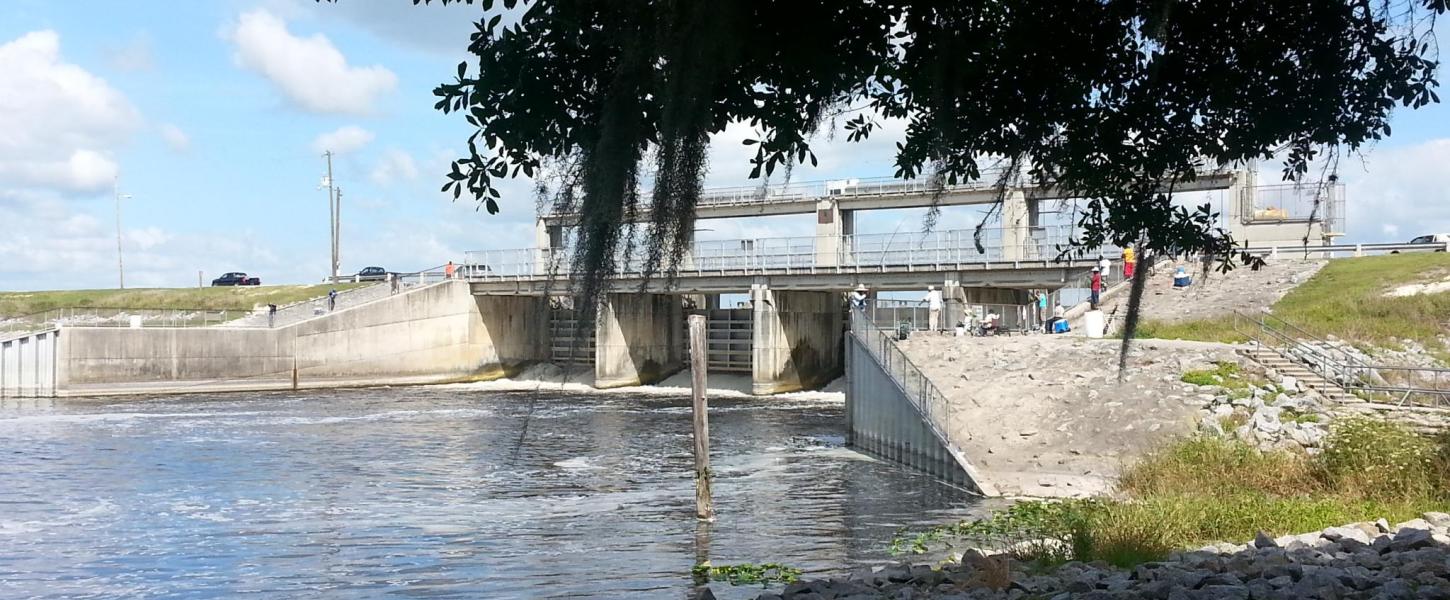Rodman Reservoir Drawdown FAQ

Frequently Asked Questions
What is the Rodman Reservoir?
Rodman Reservoir was created in 1968 as part of the former Cross Florida Barge Canal project as forest lands were partially cleared, and a 7,200-foot earthen dam was built across the Ocklawaha River. The reservoir is about 9,500 acres, 15 miles long and up to 2 miles wide in the area near the dam. A four-gate spillway (Kirkpatrick Dam) controls the water levels of the reservoir. The reservoir, from its headwaters at Eureka Dam to Payne’s Landing, consists of flooded woodlands. The transition section from Payne’s Landing to Orange Springs consists of flooded standing timber and areas of floating vegetation. The pool section from Orange Springs to Kirkpatrick Dam, including the river channel and the Cross Florida Barge Canal, consists of floating and submersed vegetation, dead-standing timber and submersed and partially submersed trees and stumps. The Barge Canal and river channel have water depths up to 30 feet deep.
Where is the Rodman Reservoir?
The Rodman Reservoir, managed by the Department of Environmental Protection as part of the Marjorie Harris Carr Cross Florida Greenway, is located southwest of Palatka off Highway 19.
What is the drawdown process?
This is a process by which water levels in the reservoir are gradually reduced to expose much of the submerged vegetation to the air during the colder months of the year. The water level is first raised to approximately 20 feet prior to the lowering phase to break loose aquatic vegetation, logs, etc. Then the lowering process is begun – preferably at a time when a strong weather front moves through – to strand as much as possible of the vegetation and debris along the shoreline as the water is lowered. The water is then drawn down to 11 feet above mean sea level. The water remains at that level for approximately three months, which provides an opportunity to manage vegetation and sediments. Submersed vegetation is exposed by the process, providing a food source for migrating waterfowl.
How often does a drawdown occur on the Rodman Reservoir?
Drawdowns are conducted every three to four years for aquatic plant control and fish and wildlife habitat enhancement. The decision to hold a drawdown was made in coordination with other agencies who have an interest in the ecological and recreational benefits of the reservoir. The last drawdown was conducted from October 2019 – April 2020.
What are the benefits of the drawdown?
The drawdown of the Rodman Reservoir provides an opportunity to maintain the ecological health and productivity of the reservoir while providing improved recreational benefits for the public. Benefits of the drawdown include:
- Oxidation and consolidation of bottom sediments.
- Temporary reduction in hydrilla coverage and number of viable hydrilla propagules in shallow areas.
- Increase in native plant diversity and coverage.
- Temporary control of floating aquatic weeds by stranding and/or freezing.
- Increased access of carnivorous fish to prey species resulting in improved game fish conditions.
- Improvement in water quality and a significant reduction in biochemical oxygen demand loading during the following year.
- Opportunities to improve and repair recreation facilities and perform spillway maintenance.
When will the drawdown begin?
The drawdown is expected to begin in October 2024. Water levels will be brought down from 18 to 11 feet above mean sea level.
How long will the drawdown last?
The water level is scheduled to remain at the drawn-down level of 11 feet through March 2025.
When will the reservoir be refilled?
The refilling process, which will raise the water level from 11 feet to 18 feet, will begin in April 2025.
Will a drawdown cause flooding of the Ocklawaha River banks?
No. The flow of water is carefully controlled at the Kirkpatrick Dam so that flooding is avoided. The release of water is gradual.
Will the drawdown impact fishing?
During the drawdown, the Florida Fish and Wildlife Conservation Commission typically closes fishing for largemouth bass. All boat ramp/access locations around the reservoir will be posted with the closure dates as they go into effect. Temporary ramps are utilized at Kenwood and Orange Springs to provide access during the drawdown. Normal fishing rules apply to all other species of fish.